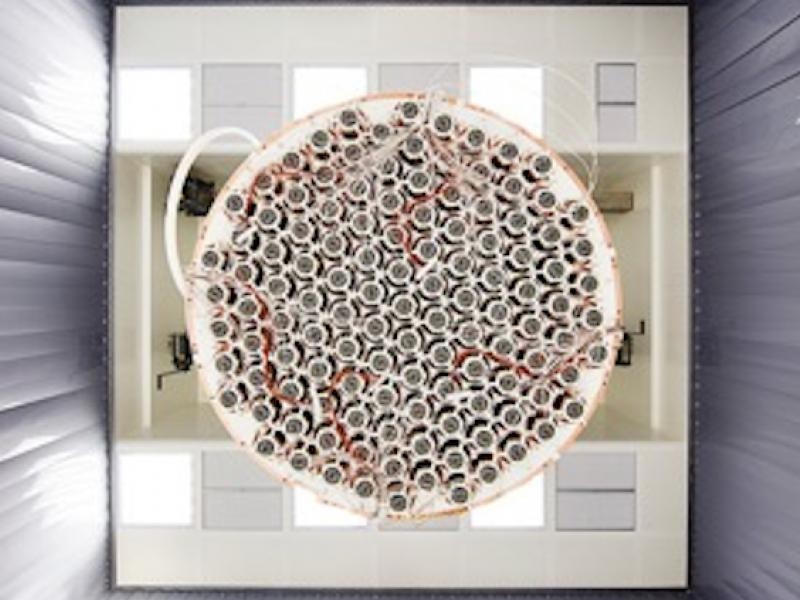Aug 23 2017
XENON1T, a dark matter detector and an underground sentinel anticipating a collision that would ascertain a postulation, has been deemed to be the most sensitive one on Earth according to the results obtained from its maiden operation.
Such high sensitivity of the detector is not only due to its size but also its “silence.” Protected by water and rock, and decontaminated by means of a sophisticated system, the detector indicated a new record low radioactivity level, a number of orders of magnitude less than that of surrounding material on our planet.
 The world's most sensitive dark matter detector demonstrates record low radioactivity levels. Credit: XENON Collaboration.
The world's most sensitive dark matter detector demonstrates record low radioactivity levels. Credit: XENON Collaboration.
We are seeing very good quality data from this detector, which tells us that it is running perfectly.
Ethan Brown, a XENON1T Collaboration member and Assistant Professor of Physics, Applied Physics and Astronomy, Rensselaer Polytechnic Institute
Dark matter is speculated to be one among the fundamental constituents of the universe, and is five times more plentiful when compared to ordinary matter. However, as it cannot be viewed and hardly interacts with ordinary matter, its presence has not been confirmed to date. Various astronomical measurements have validated the presence of dark matter, culminating in a global attempt to directly view interactions of dark matter particle with ordinary matter. Until now, the interactions have been seen to be very weak that they have eluded direct observation, compelling Researchers to construct more sensitive detectors.
From the year 2006, the XENON Collaboration has operated three successively highly sensitive liquid xenon detectors in the Gran Sasso Underground Laboratory (LNGS) in Italy. XENON1T is its highly powerful detector to date and one of the largest detectors of its kind ever constructed. Particle interactions in liquid xenon lead to the formation of tiny flashes of light, and the detector is proposed to capture the flash caused as a result of the infrequent collision of a dark matter particle with a xenon nucleus.
However, other interactions are highly common. In order to protect the detector as much as possible from natural radioactivity in the cavern, the detector—a so-called Liquid Xenon Time Projection Chamber—is positioned inside a cryostat submersed in a water tank. A mountain located above the underground laboratory also protects the detector from cosmic rays. Although the detector is shielded from the outer world, contaminants enter into the xenon from the materials used in the detector. One of Brown’s contributions is a purification system with the ability to continuously clean the xenon inside the detector.
If the xenon is dirty, we won’t see the signal from a collision with dark matte. Keeping the xenon clean is one of the major challenges of this experiment, and my work involves developing new techniques and new technologies to keep pace with that challenge.
Ethan Brown, a XENON1T Collaboration member and Assistant Professor of Physics, Applied Physics and Astronomy, Rensselaer Polytechnic Institute
Brown also assists in calibrating the detector to ascertain that the recorded interactions are accurately identified. For instance, on rare occasions, a gamma ray signal might approach the anticipated signal of a dark matter particle; hence, accurate calibration assists in eliminating similar false positive signals.
In the paper titled “First Dark Matter Search Results from the XENON1T Experiment” posted on arXiv.org and submitted for publication, the collaboration reported outcomes of a 34 day operation of XENON1T from November 2016 to January 2017. Although the outcomes did not point to detection of dark matter particles called as “weakly interacting massive particles” or “WIMPs,” the combination of record low radioactivity levels and the detector size points toward exceptional discovery ability in the future.
A new phase in the race to detect dark matter with ultralow background massive detectors on Earth has just began with XENON1T. We are proud to be at the forefront of the race with this amazing detector, the first of its kind.
Elena Aprile, Professor, Columbia University and Project Spokesperson
The XENON Collaboration is formed by 135 Researchers from the United States, Germany, Italy, Switzerland, Portugal, France, the Netherlands, Israel, Sweden, and the United Arab Emirates.
Brown’s studies are powered by the vision of The New Polytechnic, a transpiring paradigm for higher education which acknowledges that worldwide opportunities and challenges are so great that they cannot be adequately addressed by even the most talented Researcher working alone. Rensselaer functions as an avenue for collaboration among partners across disciplines, sectors and geographic regions to address complex worldwide challenges, by using highly advanced tools and techniques, most of which have been created at Rensselaer.
Investigations carried out at Rensselaer address few most pressing technological challenges worldwide, such as energy security and sustainable development and also biotechnology and human health. The New Polytechnic is life-changing in the worldwide influence on research, in its advanced pedagogy and in the lives of students at Rensselaer.